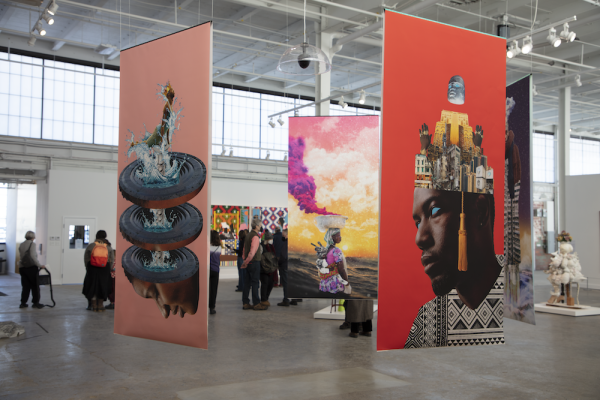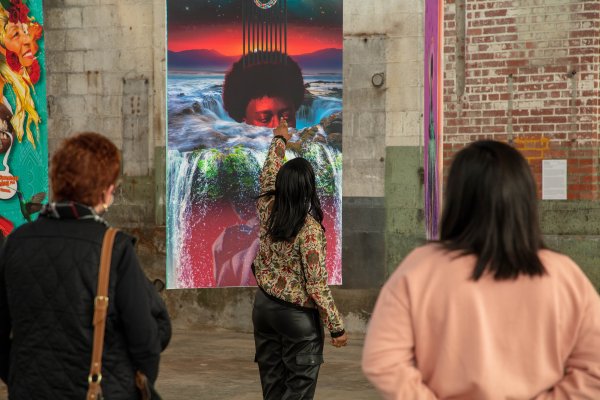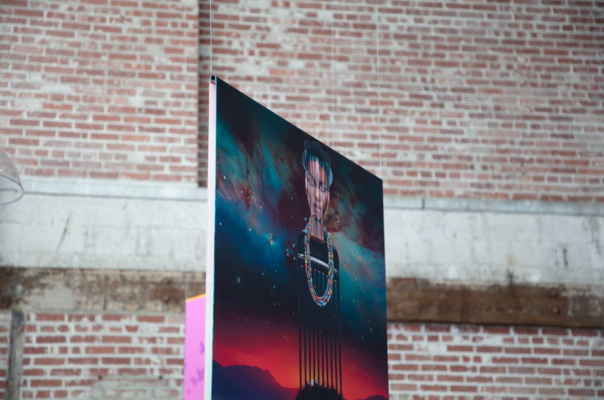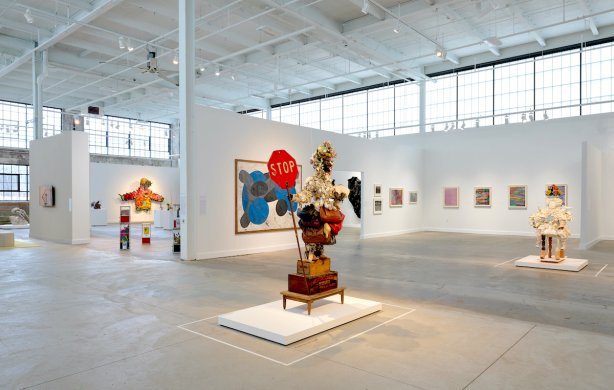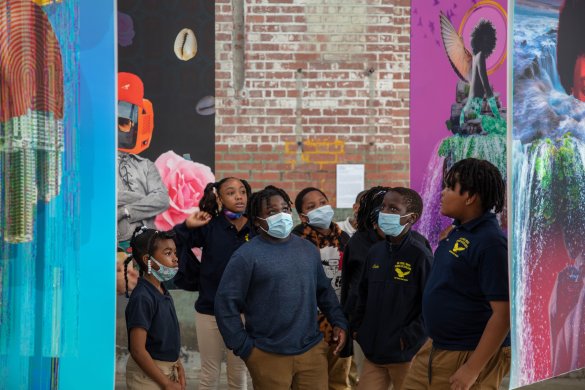In April of 2014, the artist and now professor Stacey Robinson staged an unsanctioned reading in the Albright-Knox of a manifesto: “Where is the Black art?” Robinson’s performance raised eyebrows, to say the least. Now, he and Kamau Grantham, a DJ and clinical psychologist, collaborate as BLACKMAU on works of sonic and visual collage, of which Robinson quotes the great Missy Elliott, "We so tight you get our styles tangled." Their work was part of the special exhibition In These Truths at Albright-Knox Northland (February 19–June 5, 2022). We spoke with Robinson and Grantham about their collaboration, their goals as art- and music-makers, and the role that institutions like the Albright-Knox can play in promoting a future in which Black art and Black people live and thrive.
AK: Before we get to your work together as BLACKMAU, can you describe your individual artistic and creative practices?
Kamau Grantham: For me, there's a lot of overlap with music and art. My musical expression has been DJing. I learned how to DJ my freshman year of college way back in 1988, back when everybody had a turntable. One of my friends that I grew up with happened to live next door to me in my dorm. He was a music person, and he had an extra mixer and he's like, “Do you want it?” Yeah, I'll take the mixer. So I had a mixer and one turntable. And obviously I needed a second one, so I found a second turntable and had some friends teach me how to DJ. It was just a way to take care of myself, and I made a lot of mixtapes.
When you make a mixtape—literally a cassette tape—there needs to be art with it, right? I didn't want to just give someone a blank tape. I first started cutting out images from magazines and sticking them in the cassette holder for some flavor, or I would try and do my best to do graffiti. I always wanted to do graffiti, and so I would do my own little graffiti on there. So that's how I kind of got into art.
And then Stacey and I met. My wife introduced us here in Illinois. I don’t know how it came up, but I was like, “Yeah, I do a little art on the side,” so I shared some stuff with him, and surprisingly, he's like, “Oh, this is not bad. This is not too bad.”
Stacey Robinson: Oh, you're way underselling it! I actually met Kamau’s wife first, and she was like, “You're interested in DJing? You need to meet my husband,” and then I found out that he was part of this trio that was creating the house music scene—one of the premiere house music scenes—in the Champaign-Urbana community, and at this time, I had just gotten this job at University of Illinois. I had wanted to DJ—it was a deferred dream, like, for thirty years almost at this point, and now I could afford to actually buy DJ equipment: “I put my finances in order. My children's education is paid for. I have a reliable vehicle. I think it's time for me to buy some DJ equipment.” Around this time Kamau was DJing a show in the art building right down the hall from my office, and he was like, “Dude, you want to get on? This is what you do…” And of course, I was totally jacking up stuff.
KG: No, no, that's—I don't remember that.
SR: But here's the thing: the audience didn't care, because they were there to look at art. They were drinking wine and looking at art, so nobody was really paying attention to the beats at all, but it created that buzz that was insatiable. Imagine that finally I can live my thirty-year-old deferred dream? One of my first loves has always been music. Every time I make art, I'm listening to music. There's an auditory element, artistically. I'm now just thirty years later at fifty, mid-forties–fifty, figuring out how to connect this in this way. Now it's the sound that I want to put to the artwork, and Kamau and I are very similar in this.
AK: So you met and you had these overlapping interests: the artwork that, Kamau, you're starting to make and DJing that, Stacey, you're dipping your toe in.
KG: He's bringing the art flavor, I'm bringing the music flavor, and then we're both helping each other. And so we decided to collaborate. It’s like songwriting: I had some initial chords and some lyrics going and Stacey would kind of complement that and add the bass line or the drum fills. And then we just kind of collaborated to kind of create these pieces. We did our first art show in 2019 in Urbana.
SR: Kamau is one of the dopest artists that I know, one of the dopest DJs that I know. I don't collaborate with people who are wack. You got to be dope for me to collaborate with you, because I'm not trying to carry a whole project. You know what I mean? I could do dope work myself. But working with Kamau: listening to his sounds, he makes me want to be a stronger DJ. When I'm looking at his work, he makes me want to be a better collage artist—and I thought I was pretty dope!
KG: I'll take the accolades. Thank you.
SR: I'm gonna be your hype man. Because you undersell it.
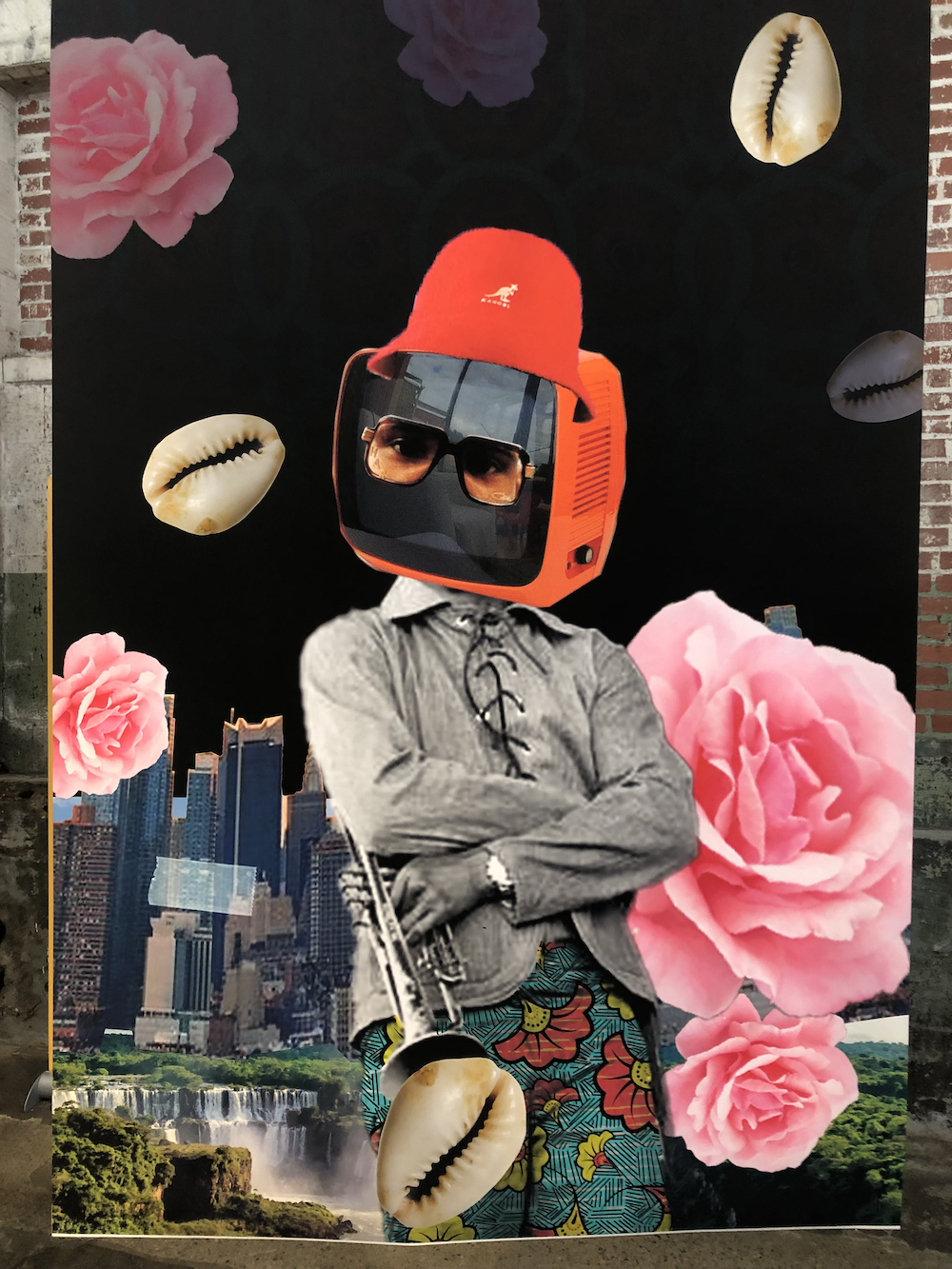
AK: Let's talk about your time as a DJ in New York, Kamau. There's a lot of interesting comparisons between collage work and DJing.
KG: The main reason I was in New York was I was working on my PhD in Clinical Psychology. And hanging out with people only in my graduate program, all they talked about was graduate school. All they talked about was psychology nonstop. And I just wasn't about that. Like Friday night: they're like, “We're going to the Albert Ellis Institute to hear about cognitive behavioral therapy, do you want to come?” and I don't want to come. No, I don't want to do that on my off time. And so I had some friends that I met there that were really in the art and music scene, and they took me in.
Musically, it's an evolution. When I started DJing in the ‘80s during college there was a routine: you had to play reggae, you had to play hip hop, you had to play R&B, you had to play house music, you had to play classics, you had to play slow jams, and rinse and repeat, right? And then later when I moved to New York, I got exposed to world music, like Afrobeat and Latin jazz, and I got into drum and bass and electronic broke beat, all that stuff. Over time, I've been able to figure out my own style, how all of that can have a space, and so when I play, I might play some old school hip hop, I might play a Brazilian jam, I might play a broke beat record, I might play a disco record from ’78, I might play a new South African house record. I play a straight up jazz record. I feel like I'm in a place now where I feel comfortable playing what I play.
AK: With artwork in In These Truths—and I know Stacey, you've done work in comics and sequential art—when I'm looking at these works, the collage creates narrative or storytelling as you move from one element to the next. I'm wondering how you see your work in comics influencing collage.
SR: I'm a storyteller. One of the things that I think about a lot is if you want black people to activate the future, where they are Black and they're free and that they liberate themselves—ourselves—you have to show them what the Afrofuture looks like. Black Audacious Freedom Dreams comes from two different books: The Audacity of Hope [by Barack Obama], and then Freedom Dreams by Robin D.G. Kelley is a major influence to how I'm thinking about this particular work. But it also is a surreal space. Black Freedom is surreal. What does that look like? Like it looks dreamlike. What I argue is most of the world is not free. So when I think about black people, when I think about freedom, I don't just refer to the Emancipation Proclamation. And before now, I think that most of the world is actually enslaved to colonial systems, or imperial systems. What does that look like? I'm trying to make people aware so that they cannot unsee what a black audacious free space looks like.
But I think it also has an auditory element. Because I think the visual art sounds like something, I think when you look at it, you imagine a sound, and I like to experiment with that too. In that particular piece that we have in the Albright right now, there's a speaker that is playing sound right in the center of the space. So when you stand in the center of it, you can hear what that space sounds like.
Part 2: Next week, the conversation continues as BLACKMAU talks about race, mental health, and the work that cultural spaces can do to promote a Black future.
Follow BLACKMAU on Instagram @blackmau_official.
See more of Kamau Grantham's work as DJ KamauMau with Dance Music Therapy, a group of DJs on a mission to create a safe space for everyone to enjoy dance music with events this summer in the Champaign-Urbana, Illinois are, and listen to his work on his SoundCloud, Mixcloud, or follow him on Instagram @kamaumau.
See more of Stacey Robinson's work at @staceyarobinson.
